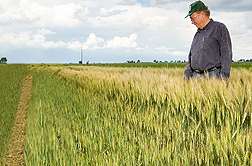Squeezing More Crop Out of Each Drop of Water

(PhysOrg.com) -- Studies in China and Colorado by Agricultural Research Service (ARS) scientists and cooperators have revealed some interesting tactics on how to irrigate with limited water, based on a crop’s critical growth stages.
Laj Ahuja, research leader at the ARS Agricultural Systems Research Unit in Fort Collins, Colo., and colleagues conducted the studies.
As one example, with wheat in China, they found it best to use 80 percent of the water for wheat’s two critical growth stages. In Colorado, it was best to use 80 percent of the water for corn’s critical flowering and grain filling stages.
Other tactics for putting limited water to best use are to irrigate only part of a field, skip the pre-plant irrigation for corn, delay irrigating until up to half of the soil water is depleted, and wet soil to no more than 70 percent of field capacity.
Ahuja and his colleagues came up with the findings in China by combining the ARS Root Zone Water Quality Model with the Decision Support System for Agrotechnology Transfer crop growth modules.
While the combination of models has been used in other experiments to test alternative water and nitrogen management practices, this is the first time these models have been used to evaluate crop responses to lack of water across critical crop growth stages, and the first to use long-term weather data.
In Colorado, they used the models for simulations, relying on local weather records dating back to 1912. In China, the simulations used records from 1961 to 1999.
The scientists also found that farmers irrigating in China could cut back their nitrogen fertilizer use by a third, reducing nitrate leaching by 60 percent without affecting crop yields.
The experiments demonstrated that crop simulation models enable fast and cheap transfer of technology from research labs and experimental stations to farmers’ fields. Coupled with local field experiments, they proved to be an excellent tool for making the best use of limited water.
Read more about this research in the October 2009 issue of Agricultural Research magazine.
Provided by USDA Agricultural Research Service

















